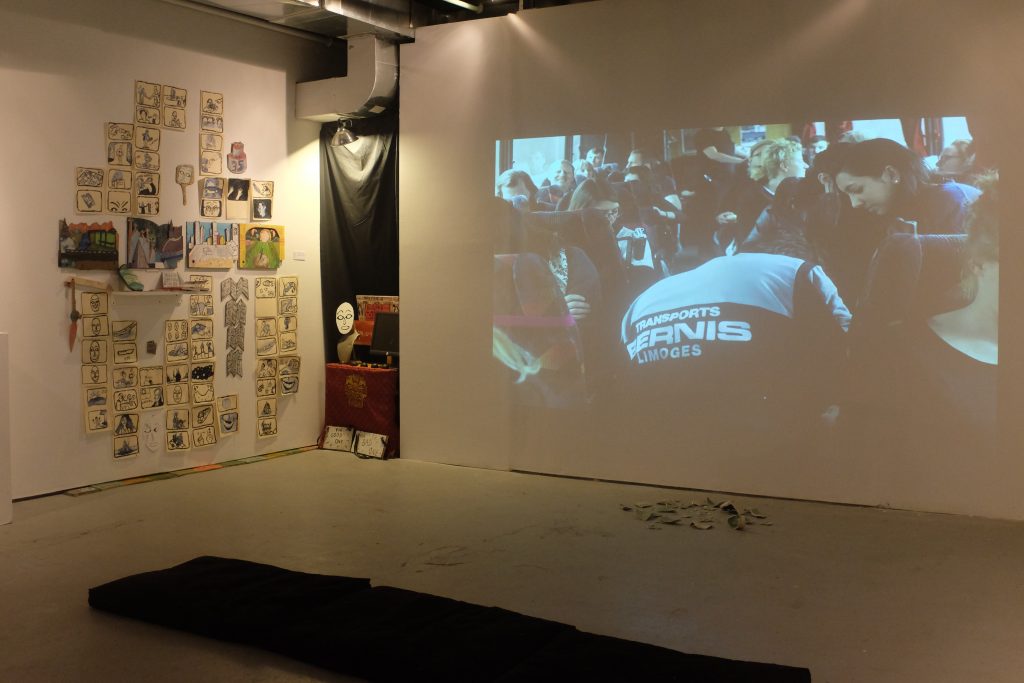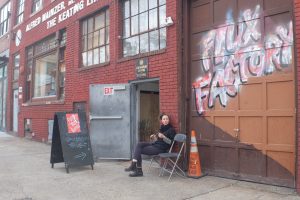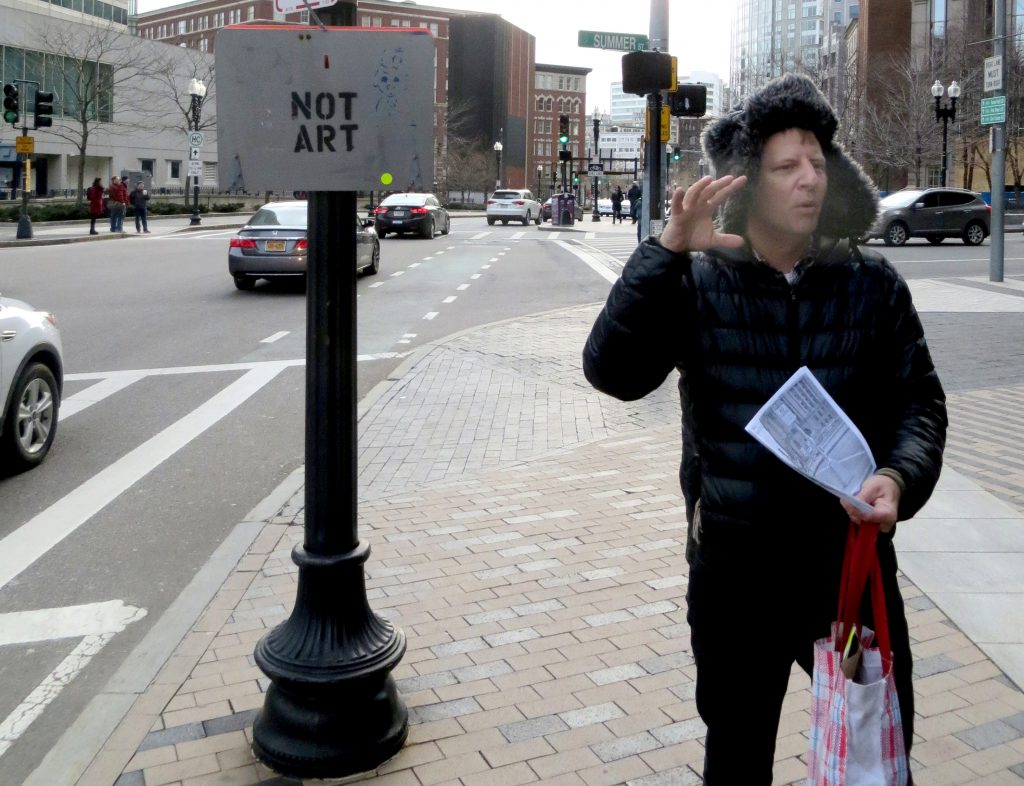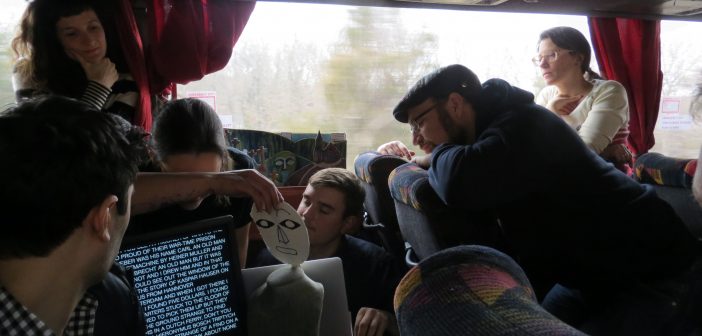Flux Factory—an alternative art space in Queens—hit the road for the Fung Wah Biennial on March 5th. Curator Will Owen spearheaded the mobile art exhibition with the support of Flux board member Sally Szwed and former curator in residence Matthias Hvass Borello. The month-long show consisted of three separate Chinatown bus trips to Boston, Philadelphia, and Baltimore, and three off-board activities with partner spaces in each city. Three documentarians recorded these artworks for the later exhibition at Flux Gallery, where artifacts and recordings of the en route interventions highlighted the Biennial’s major themes: proximity, hospitality, history and migration. These themes were further animated by a certain sense of urgency, though expressed obliquely, surrounding the challenges facing artists and artist-run spaces trying to stay in their communities as development and real estate speculation drive costs up.
I rode along for the mobile Biennial’s Boston leg (the first destination of the month). My trip began early Saturday morning in the Lower East Side. Over twenty-five artists organized twenty-four separate projects. It was far from the average Chinatown bus commute. Hoisting crowd-surfing passengers over our seats; reading a live text drama using Whats App; and perusing the “Land Mall” magazine in our seat pockets, barely left time to nap. On the final stretch, as we crowded around a pair of seats to watch Seth Timothy Larson and Abigail Entsminger’s enigmatic, participatory theatre piece Legend of Buspar, the bus emerged from the tunnel into Boston.

Fung Wah Biennial Exhibition, Flux Factory, March 25, 2016. Photo Credit: Lena Hawkins.
So why put an art show on wheels? In a recent Skype interview, Owen explained that he took his first Fung Wah trip to visit his sister in Brooklyn when he was seventeen and living in Boston for the summer. Although the line began as a service mainly for commuting Chinese workers and restaurant deliveries, it began to attract young students like Owen looking for cheap travel between cities along the Northeast corridor. Despite its fraught safety record that ultimately led to its final closure in 2015, Fung Wah nonetheless democratized travel for migrant workers, artists, college students, and their visiting parents. It was his boredom during one of these trips, as well as his interest in the way that the bus’s form was akin to a lecture hall or theater, that sparked Owen’s idea for the Biennial. The bus, he explained, is an ideal place to explore broader themes of travel and displacement: “so much migration is based on seeking something better for yourself…or seeking refuge from a terrible situation… for instance…New York has become this intense bubble of exuberant costs for real estate.” Owen observed that whereas some artists used to move to New York for the arts scene and visit other cities only to take a pulse of their scenes, nowadays he observes a trend of artists moving to other places and returning to New York to participate in the arts.
This economic uncertainty and a curiosity about other cities’ arts scenes drove the curators to find comparable spaces in selected sites. They partnered with Atlantic Works Gallery and Makeshift Space in Boston; Asian Arts Initiative, Space 1026, and Vox Populi in Philadelphia; and Current Space in Baltimore. Specifically, they targeted artist-run spaces that had been around for more than five years (the length of a typical gallery lease) to find out, among other things, how they were able to endure. As the bus made its pilgrimage to these cousin spaces, I couldn’t help but feel like it was research for an escape plan. But was it an escape from a particular problem in New York or a much broader phenomenon? The precariousness of place for artists, perhaps even their own role in boom-and-bust development cycles, is, in fact, on the minds of many in the city.

Exterior of Flux Factory, Long Island City, Queens, New York City, March 25, 2016. Photo Credit: Lena Hawkins.
Just a few days prior to the bus’s departure, Planners Network convened a forum in Brooklyn to discuss the cost of rampant speculation in the city’s commercial property market and strategies for preserving small businesses, manufacturing, and artist spaces. As rents continue to rapidly increase, the rate of commercial evictions rise, and vacancies linger, activist groups like TakeBackNYC and the Artist Studio Affordability Project are asking officials to acknowledge the crisis and pass new regulations. Many at the forum were hopeful that commercial rent control might become politically feasible. There is already a longstanding piece of proposed city legislation—The Small Business Jobs Survival Act—which would introduce rules to give more rights to commercial tenants. Other Groups are trying to find alternative models. For instance, the new group NYC Real Estate Investment Cooperative seeks to leverage political power and create a mechanism for New Yorkers to invest money in securing permanently affordable space for civic, cultural, and cooperative use in the city.
Despite the rise in commercial evictions, data about artist displacement is mainly anecdotal. The Planners Network panelists noted that some of the displaced set sights on Queens, while others move back to their hometowns in other states, or to smaller cities like Detroit, Boston or Philadelphia. In Boston, the bus paid a visit to Atlantic Works Gallery near Maverick Square. Could this place be a new home for artists fleeing the five boroughs? As it turns out, East Boston itself faces looming gentrification, and some locals at the gallery were concerned about encroaching real estate development.
While partners like Baltimore’s Current Space were involved in anti-gentrification organizing, the works shown on the bus itself didn’t directly address the issue of displacement; yet a sense of itinerant uncertainty and themes of permanence vs. change ran through them. Fan Letters, the name of Dylan Neely and Alex Nathanson’s audiovisual collaborative, planted several musicians in seats around the bus to perform an emergent piece called Music to Another City. Whenever a plane flew by or a tollbooth appeared on the horizon, a musician would start playing a short motif on mandolin or melodica. Other cues were abstract and subjective, like “leaving New York.” Neely told me, “It’s interesting to see how the cues are being interpreted, and where people define cues like ‘leaving New York,’ which is very specific to each person’s experience of New York and what they see out their window.” The result of Neely and Nathanson’s work was a remarkable four-hour composition that seemed to narrate our journey across the intercity landscape. As both a navigational tool and cultural transmitter, the piece brings to mind other works of geospatial storytelling, like Benjamin Chafee’s Music for Circumstances, a series of recordings produced for listening along specific routes in Boston.
There was a palpable tension between the emergent and ritualistic qualities of Music to Another City. Although the performance could never repeat itself, the piece also spoke to a common experience of taking this particular path along the northeast corridor, telling both an informational and reassuring story for fellow travelers. If one was to write lyrics, would they tell of artist migrations of generations past, either struggling to make it to the city or escape ‘back to the land’? In many of the works that didn’t speak to displacement directly, there was nevertheless an implicit question of whether the ‘place’ of an artist could be interchangeable, and the costs and benefits of transplanting one’s self into a new environment.
Some of the city-based activities spoke to the provocation of ‘transplant art’ quite literally. Eric Doeringer (an artist known for recreating works by other artists) chose to replicate a 1968 conceptual piece by Douglas Heubler called Boston New York Exchange Shape. Heubler–in an era before Google Maps–had plotted a hexagonal shape onto both cities and taken photographs at each of the vertices, creating a geospatial dialogue between the cities.

Eric Doeringer leads a walking tour of sites photographed in Boston -New York Exchange Shape, March 5, 2016.
In Boston, Doeringer led us on a walking tour retracing the hexagonal path through the city. He explained what it was like retracing Heubler’s path nearly fifty years later: “In Boston, stuff like the Big Dig created a really big difference...In NYC, there’s an awful lot of construction going on, but there wasn’t that much change…” Doeringer recounted using similar or sometimes the original lampposts and fire hydrants to align his photos to the originals. Like Music to Another City, Doeringer’s reenactment conjured not just a sense of uncertainty of place in the present, but also historical cycles of change and movement. It may seem like a ridiculous proposition to exchange pieces of different cities like a puzzle, but in an era where some local institutions like New York’s Galapagos Art Space are quite literally transplanting themselves to cities like Detroit, reality may be stranger than concept. By transplanting Heubler’s conceptual sculpture across time as well as space, Doeringer brilliantly provoked participants to question the narrative of the artist on the move, and whether it’s a story doomed to repeat itself.
Whether or not the Fung Wah Biennial succeeds in plotting a path through precarious times for artists, the first trips turned the notion of a wholesale arts exodus from New York into an enjoyable, almost satirical spectacle. Packing up a portion of the city’s art scene and cramming it on to a budget bus is such an extreme prospect that it highlights the challenging conditions working artists—along with small proprietors and manufacturers—now face. It also joined what is perhaps a growing trend of critical work poking fun at the biennial system itself as an institution that, in Owen’s words, “represents… a certain crust of the art world which can be perceived as arcane or haughty on a number of levels.” Owen envisions the show’s impact as weaving a network of “cousin” spaces in other cities and sharing knowledge to help each other be more resilient and supportive of their communities. If the event happens again in some form as the curators hope, it will be interesting to see how these relationships grow. Although the Biennial showed how compelling and fun dreaming of an escape from the city can be, it also reminded passengers that the bigger, tougher challenge may be figuring out how to break the economic cycle and stay for good.

